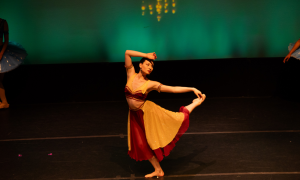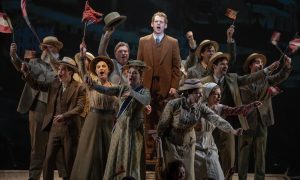Citizens Bank Opera House, Boston, MA.
March 16, 2024.
The classic Disney canon is nostalgic for many of this reviewer’s generation. Maybe we re-experience it when we have our own children and watch with them, or when these stories resurface in the cultural zeitgeist. If you’re me, you return to them as a dance critic (certainly no complaints there).
Through any of those avenues, we can be flooded with sweet nostalgia. I felt that with taking in Boston Ballet’s Cinderella, even with the company’s typical way of infusing a dash of the modern into a classical mix. Whether classic or modern, the fantasy and magic at hand could capture our hearts and bring us into a whole new world for a short time. Malin Thoors and Wendy Ellis Somes directed, supervised and staged the program. Choreography is from Sir Frederick Ashton.
We began this trip into the fantastical – a realistic world nevertheless touched by magic – with lighting dappling the curtain before it rose (lighting design by Brandon Stirling Baker). It did so on Cinderella’s father’s home, with her working away in the corner and her stepsisters being their flamboyant, somewhat ridiculous selves. Delightfully portrayed by Graham Johns and Lawrence Rines Munro, complete with giant wigs and outlandishly loud garb, there was a “drag” element to these characters.
These two are villainous, even relentlessly vicious, in many Cinderella portrayals. Yet in Boston Ballet’s, they came off (to this reviewer at least) as more bumbling and comical. That’s in line with the accessible humor in Boston Ballet programs such as Mikko Nissinen’s The Nutcracker. It also aligns with a more modern ethos of refraining from judgment of our fellow humans; labels such as “a good person” or “a bad person” can feel too simplistic when we consider the complexity of the modern world and the lives within it.
The titular character, Cinderella, didn’t stay working in the corner – unseen, uncared for – for long. The stepsisters left, and Cinderella took up all the space at hand to dance with her broom. Lia Cirio danced the character with a sense of the character’s full humanity: her innocence and goodness, yet also resilience and persistence. In this first scene, however, Cinderella exuded a quality more on the sweetness and softness side of that spectrum – a young woman dreaming of a better life for herself, perhaps even of a better world beyond her.
The lilting, romantic score (by Sergei Prokofiev, conducted by Mischa Santora) enhanced that sense of dreaminess – and brought me back to when I took this story in (repeatedly…sorry, mom!) as a very young girl. Soon, Cinderella met her Fairy Godmother – which Seo Hye Han danced with all of the sprightliness and effervescence of a truly magical being. The easeful accents in her movement created a soft, kind energy.
An enchanting wood, of sparkling light and gray shadow, was all around them (scenic design by Toer van Schayk). With a bright moon overhead, the score translated a sense of the grand, the celestial, the cosmic. Fairies of each season then came to dance for Cinderella. The Fairy Spring (Nina Matiashvili) danced with the slightly cautious, yet fully joyful sense of new life emerging. The Fairy Summer (Haley Schwan) brought the feeling of the languid, yet wholly energized continuity of a long beach day.
The Fairy Autumn (Chisako Oga) moved with the purposeful freneticism of squirrels gathering nuts for their hibernation store. The Fairy Winter (Lauren Herfindahl) danced with the repetitive, staccato quality of crunching steps in snow. Following them were a captivating corps of dancers embodying Stars, with the smooth waltzing of the Nutcracker’s Flowers and the punchy small jumps of its Snow.
Just before the first intermission, Cinderella appeared at the palace – completely transformed (costume design by Christine Haworth). As a clever translation into the ballet medium, dancers carrying Cinderella’s veil followed her – no giant pumpkin carriage in sight. The curtain fell, and we in the audience were left in compelling suspense for what would transpire there. Although, if we know the story – and most of us do – we knew what would happen. The fun part can be half-forgetting it for just a moment, to at least somewhat experience it anew.
The Second Act settled us in the palace for longer. Its opulence – tasteful rather than ostentatious – contrasted the relative modesty of where Cinderella lived. Court dancers moved with both brightness and grounding, inflecting ballet vocabulary into classic court dancing. Cinderella’s stepsisters were also there, in all of their flashy buffoonery.
Daniel Durrett danced the charming Jester, bringing pure fun and vibrancy to this very serious court ball. The pageantry of trumpets and all standing at attendance welcomed the Prince (Lasha Khozashvili). Throughout, he danced feather light and with lovely lines for days.
Cinderella and the Prince danced, something we would all see coming. As was the case for the program overall, there was also something wholly fresh and inventive on offer; the Stars and Fairies of the Seasons also came to dance. Surrounding them dancing, it was as if the Stars and Seasons were blessing this dance. This spoke to me of nature itself encouraging the meeting and interacting of these two people – fated, predestined, one could even argue.
Whether or not, the circle of sparkling dancers around the Prince and Cinderella was an aesthetic balm to the very soul. Yet the atmosphere shifted as the clock struck midnight. A purple-blue light settled over the space, and Cinderella ran off. The Prince waved goodbye to her, wistful and even sad. The curtain fell for the second intermission – creating another suspenseful chapter break.
Act III opened with Cinderella running away, off into the woods and away from the castle. Other pairs of lovers – each with a unique couple dynamic – also traversed the woods. That brought a sense of others peripherally connected to the story at hand, a whole community engaged with the prince’s court.
Next, we were back at Cinderella’s father’s home. Soon the Prince arrived, with all of the pageantry typically in his orbit – including the Jester. We who know the story (and again, that’s most of us) knew what the Prince sought: the woman who wore the shoe, the shoe that was the only thing that he had left of her. As much as the stepsisters tried to force their too-large feet into it, they had no such luck.
Then came the magical moment of the shoe fitting on Cinderella’s foot, and the Prince recognizing her. The Jester literally leapt for joy, and the Fairy Godmother appeared as if blessing the moment. The Seasons, Stars, and Prince’s friends all came to dance. A whole ensemble was there to celebrate the union of the Prince and Cinderella (though, as quite the understatement, the stepsisters were not too pleased) – their fairy-tale ending, one of all being right in this realistic, yet magical world.
Even with that fairy-tale quality, Boston Ballet’s presentation of the classic tale had its typical touch of a modern aesthetic and sensibility. If looking from such a more contemporary lens, one might question (as I did at one or two points while watching): do we really need to keep telling stories about princes and princesses, when they so diverge from the world of 2024?
Well, Cinderella certainly has powerful things to say about matters such as class, upward mobility and reaching one’s highest aspirations no matter their societal role. Let’s also remember that – although I began this review talking about Disney princess nostalgia – these stories are much, much older (and often more gruesome).
Any of that aside, maybe the beauty and sentimentality of such retellings is enough. Maybe basking in all of that is a break from thinking about concerns of our hectic modern world. Whatever any given audience may experience, Boston Ballet’s Cinderella certainly invited them into something magical, something wondrous, something to treasure. May we not forget how special that alone can be.
By Kathryn Boland of Dance Informa.















